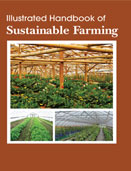Handbooks

Sustainable farming is farming ecologically by promoting methods and practices that are economically viable, environmentally sound and protect public health. It does not only concentrate on the economic aspect of farming, but also on the use of non-renewable factors in the process thoughtfully and effectively. Sustainable farms produce crops and raise animals without relying on toxic chemical pesticides, synthetic fertilizers, genetically modified seeds, or practices that degrade soil, water, or other natural resources. By growing a variety of plants and using techniques such as crop rotation, conservation tillage, and pasture-based livestock husbandry, sustainable farms protect biodiversity and foster the development and maintenance of healthy ecosystems. This illustrated guide focuses on maintaining economic stability of farms and helping farmers improve their techniques and quality of life.
In the last 20 years, a growing movement has emerged to promote the development and implementation of sustainable farming practices. A sustainable Agriculture is a system of agriculture that is committed to maintain and preserve the agriculture base of soil, water, and atmosphere ensuring future generations the capacity to feed themselves with an adequate supply of safe and wholesome food. Despite its growing popularity, the concept of sustainable agriculture is still evolving as it encompasses both changing attitudes towards farming and developing environmental awareness.
Illustrated Handbook of Sustainable Farming examines current agricultural issues caused by the technological revolution in farming practices and explains the long-term benefits of sustainable farming systems. Over the history of human settlements on the planet earth, agriculture has transformed in tune with the growing population and its challenging needs. The ultimate goal or the ends of sustainable agriculture is to develop farming systems that are productive and profitable, conserve the natural resource base, protect the environment, and enhance health and safety, and to do so over the long-term. The means of achieving this is low input methods and skilled management, which seek to optimize the management and use of internal production inputs (i.e., on-farm resources) in ways that provide acceptable levels of sustainable crop yields and livestock production and result in economically profitable returns. This approach emphasizes such cultural and management practices as crop rotations, recycling of animal manures, and conservation tillage to control soil erosion and nutrient losses and to maintain or enhance soil productivity. Low-input farming systems seek to minimize the use of external production inputs (i.e., off-farm resources), such as purchased fertilizers and pesticides, wherever and whenever feasible and practicable: to lower production costs: to avoid pollution of surface and groundwater: to reduce pesticide residues in food: to reduce a farmer?s overall risk; and to increase both short-term and long-term farm profitability. Another reason for the focus on low- input farming systems is that most highinput systems, sooner or later, would probably fail because they are not either economically or environmentally sustainable over the long-term.
Illustrated Handbook of Sustainable Farming showing how the method of sustainability assessment plays a key role in choosing the best agricultural productive mode, this book guides the students and researchers through the process of selecting the various approaches for sustainable farming.